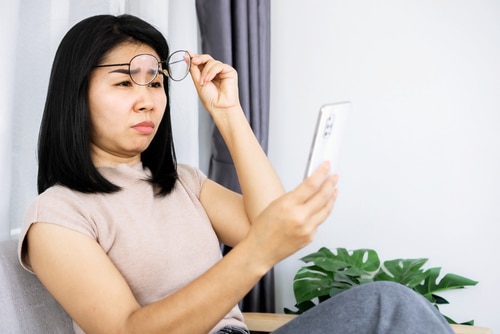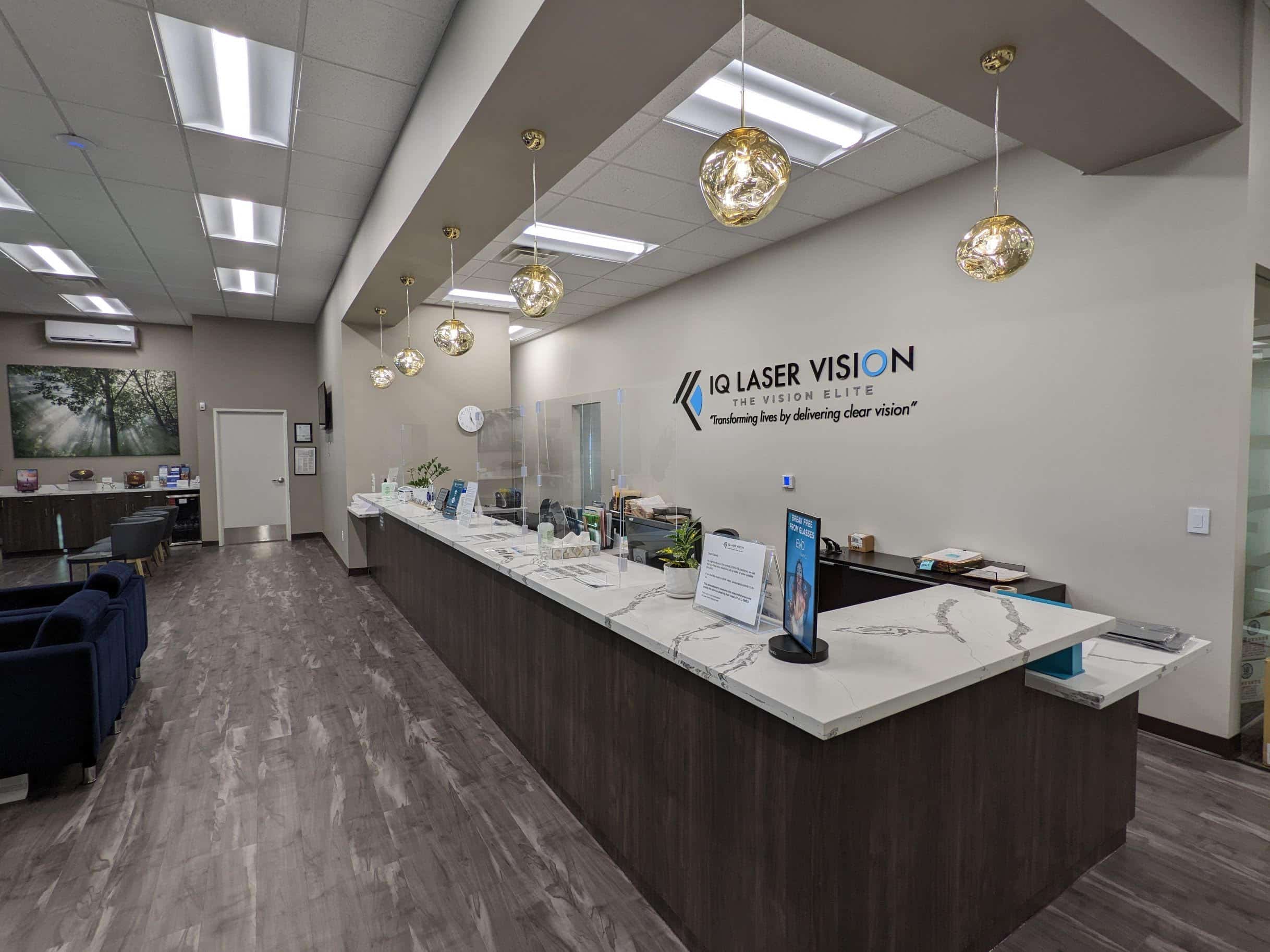
Have simple tasks like reading a newspaper, texting, or seeing the computer screen become much harder? Do you find yourself depending on your reading glasses to see more around you?
These are some of the common signs of presbyopia. The ophthalmologists at IQ Laser Vision are here to answer all your questions about this condition and how to treat it!
What is Presbyopia?
Presbyopia is a condition that develops as a result of aging. This occurs because the lens becomes less flexible and hardens. With a less flexible lens, it becomes harder to see things up close. It also prevents people from focusing. You’ll notice this most when you’re between the ages of 40 to 65.
You may find yourself needing to hold books and newspapers close to your face to be able to see them and read them. At any other distance, things will be too blurry to see.
Don’t be surprised if you experience headaches, eye pain, or fatigue after reading or trying to complete any close-up projects like scrapbooking. If you didn’t sleep well the night before and are already tired, this can make symptoms of presbyopia even worse as well, so a good night’s sleep is even more important!
If you want to be able to see, you’ll need more light than normal, since low light can increase both blurriness and eye strain. This will make your eyes work harder than necessary to see.
What Causes Presbyopia?
Your cornea is the clear, rounded surface on the outside of the eye. This dome shape works with the lens beneath it to bend the light that is entering the eye. A flexible muscle surrounds the lens, tightening when you look at nearby items. This motion curves and focuses the lens. When you look far away, the muscle loosens, flattening the lens so you can focus on the distance. With presbyopia, the lens is not as flexible as it used to be when you were younger.
It’s just one more thing that aging makes harder! A less flexible lens makes it almost impossible to focus on nearby objects.
What are the Risk Factors of Presbyopia?
- If you’re farsighted, you are more likely to develop presbyopia before the age of 40. Heart disease, diabetes, and multiple sclerosis also increase your chance of developing the condition at a younger age.
- You may also increase your risk of developing presbyopia if you take medications like diuretics, antidepressants, and antihistamines. Talk to your doctor if you’re concerned that you take medications that might have this side effect.
When Should You See a Professional About Presbyopia?
Generally, presbyopia isn’t something you really need to worry about as it’s easy to manage. But you may want to see your eye doctor at IQ Laser Vision if blurry vision makes it almost impossible to complete your daily activities or you suddenly have trouble seeing anything at all.
If you start seeing more flashes of light, experience double vision, or halos, these can also be signs of something more serious than presbyopia that you should have treated right away. If you suddenly experience any vision changes, it never hurts to be safe rather than sorry!
What are the Treatment Options for Presbyopia?

One of the most common ways to treat presbyopia is by wearing glasses. Even if you’ve never needed glasses before, wearing reading glasses can help you focus and see things clearly again!
There are different kinds of glasses that you can wear, depending on your presbyopia and what kind of prescription you have. Although it sounds odd, you can have presbyopia in only one eye. That means you need a different strength prescription for each lens.
Bifocals
If you’re nearsighted and struggle to see things that are far away, you may want to wear bifocals. These lenses have two sides.
The bottom of the lenses has higher-strength prescriptions, making them ideal for up-close work. The top of the lenses makes it easier to focus when looking at something far away.
Progressive multifocals
Another lens that’s similar to bifocals are progressive multifocals. But instead of a line between the two sides, they feature a middle-distance lens strength between the two halves.
This section erases the line between the lens strengths. This way, no one can tell that you are wearing bifocals.
Monovision contact lenses
If you have presbyopia, you can wear monovision contact lenses. These sets have one prescription for nearby vision and another for distance viewing. There are also modified monovision contacts. These sets have one prescription lens for distance. The other is bifocal or multifocal.
You can use both eyes for distance and one for reading. Although you can wear glasses if you have presbyopia, you can also wear contacts if you don’t want to tell the world you have presbyopia!
Are There Surgical Options to Treat Presbyopia?
If you don’t want to continue wearing glasses or contacts to treat presbyopia, there are surgical procedures that treat the condition. These include:

LASIK
LASIK is a popular elective procedure that permanently reshapes the cornea, resulting in corrected vision! Most patients who have LASIK end up with 20/20 vision or better, which is part of LASIK’s immense appeal.
To find out if LASIK could be right for you, schedule a LASIK consultation at IQ Laser Vision now!
PRK
Another vision correction procedure you may want to consider is PRK, which is a procedure that’s a lot like LASIK. During the procedure, your surgeon removes the outer layer of the cornea, called the epithelium.
There is no flap created during PRK, which makes it a great choice for people with presbyopia who don’t qualify for LASIK. Removing the epithelium reshapes the cornea and makes it easier for patients with presbyopia to see close-up.
The epithelium heals on its own as you recover after having PRK, which can take several days, but it can take a few months before you’ve completely healed after the procedure. Like LASIK, PRK is a permanent way to correct your vision!
LASEK
LASEK is a procedure that removes the epithelium. After removing the epithelium, a laser is then used to enhance the curve of the cornea. The epithelium is replaced and then left to heal. This procedure is often recommended if you are not right for LASIK.
SMILE
Another procedure to consider if you don’t qualify for LASIK is SMILE. With SMILE, there is no flap created. Instead, a tiny incision of approximately 4 millimeters is made inside the cornea. SMILE is a permanent procedure that’s FDA approved for patients with nearsightedness between -1 and -10 diopters and mild astigmatism that’s up to 3 diopters.
Because the incision created in the cornea is so tiny, it’s often recommended for patients with thinner corneas, dry eye syndrome, or larger pupils who have been told that LASIK is not right for them.
Refractive Lens Exchange
If you have presbyopia, Refractive Lens Exchange or RLE may be the best vision correction option for you. RLE is a lot like cataract surgery since it involves removing the natural lens of the eye. It is then replaced with an artificial lens, known as an IOL. The difference is that people with presbyopia may not have cataracts yet.
RLE can be a good procedure to consider if you have presbyopia and don’t want to deal with having cataracts later on down the road. That means you’ll never have to have cataract surgery, either!
How Can I Prevent Presbyopia?
There is no way to guarantee you’ll never develop presbyopia. But if you don’t want to develop it early, there are some things that you can try to stop it.
Protect your eyes
Protect your corneas by wearing safety goggles or glasses to prevent eye injuries. Developing an eye injury can cause your lens to become less flexible.
Avoid eye strain
Always use enough light to read. This makes it easy for your eyes to focus and avoids potential eye strain.
Eat for healthy sight
Eat foods with vitamin A, antioxidants, and beta carotene. These nutrients promote healthy sight. They can also slow the development of farsightedness.
See your eye doctor regularly
You should visit your doctor every 1-2 years if you’re between the ages of 20 and 39. If you wear glasses or contacts, see your eye doctor once a year to ensure your prescription is up to date.
Make sure to schedule an eye appointment appointment annually if you’re 40 or older or have any eye conditions that run in your family. Regular appointments increase the chances of finding serious vision issues. Seeing your eye doctor regularly at any age can help keep your eyes healthy and help you live a better life!























